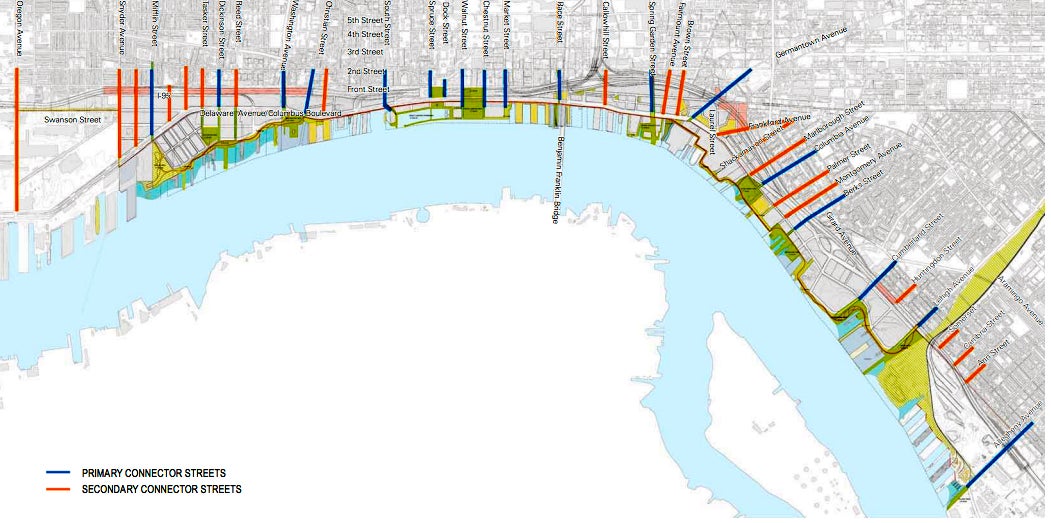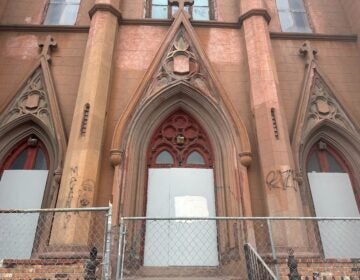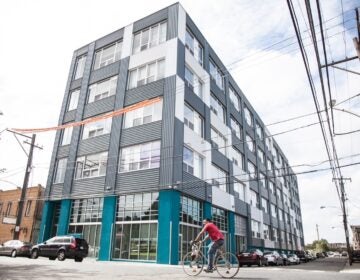CDAG’s overlay angst: Group worries about blocked river views, developments fronted with parking lots and too much signage

Members of the Central Delaware Advocacy Group are concerned that changes in the latest draft of the Central Delaware Overlay could result in blocked river views, developments fronted with parking lots and too much signage.
CDAG members discussed the changes at a Thursday morning meeting, in preparation for an overlay discussion between some CDAG members and city planners next week.
An earlier version of the overlay prohibited the building of permanent structures that would block the future extension of 10 key river access streets to the river. “That has been eliminated from the latest draft,” CDAG member Joe Schiavo reported to the group.
Both Schiavo and CDAG president Matt Ruben cautioned the group that some of their concerns may be addressed outside the overlay, in the underlying zoning code itself.
But the river access streets issue is not addressed elsewhere “as far as we know, but we could be wrong,” Ruben said.
When told of CDAG’s concerns in a phone interview, Planning Commission Deputy Executive Director Eva Gladstein, who has overseen the development of both the new zoning code and the drafting of the Delaware Riverfront overlay, said the prohibited permanent structures language was removed, but then replaced with a section called site design. The new language still provides for public access to the waterfront, she said.
But unlike the older language, the new language does not ban development that would block the future extension of any of the 10 river access streets.
The river access language applies only when a proposed development at one of the 10 streets would stand between Delaware Avenue or Christopher Columbus Boulevard and an existing park and recreational trail. A park or trail that is planned, but not in existence, wouldn’t count, Gladstein said.
And it requires development plans to include a 12-foot wide “open area of unencumbered space” to allow pedestrians to travel through the property. That path wouldn’t have to be a straight shot. Twelve feet isn’t wide enough for a street.
“It’s a little bit less prescriptive,” Gladstein said. “We don’t know if and when the (river access streets) will be platted,” she said. And if they are, they “might not be straight.”
Gladstein made it clear that this language is still in draft form, and that discussions with CDAG and other stakeholders are continuing, so it could again change.
River access and street grid extension are key goals in the Central Delaware Waterfront Master Plan. Delaware River Waterfront Corporation Planning Director Sarah Thorp, who oversaw development of the plan, said the wording change in the overlay does not alarm her. Her understanding is that city planning thinks the zoning overlay isn’t the right place to accomplish some of these goals. But there are other tools that might work better, Thorp said. The more approriate place might be during the street platting process, Thorp said.
DRWC won’t be asking the city to plat streets, she said. That’s a matter of city policy, and it is linked to the timing of development. “In places where developments might happen sooner, it probably should get done more quickly,” she said. But it doesn’t make sense to platt streets now in places where development is far-off.
In short, Thorp said, DRWC trusts planning’s judgment. “The restrictions need to go somewhere, in some kind of policy, at some point,” Thorp said. But the overlay doesn’t have to be where.
CDAG’s desire that there be no parking lots fronting developments along Delaware Avenue remains addressed in the overlay, Gladstein said. Under both the last and the current draft, there is no outright ban on such lots, but combined with sidewalk and setback requirements, there is just no room. The language was changed for clarification, but has the same effect, Gladstein said.
In an earlier discussion with Gladstein, CDAG members asked that the list of prohibited uses included in the current zoning overlay also be included in the new overlay. It still isn’t in there, and Gladstein said Thursday, as in the past, that including the list would be redundant in most cases, because the uses are banned in the base zoning. “There are already very few to no opportunities,” for these uses by-right, she said. But planning is now doing research on the matter, and if it turns out there is property where some of the uses would be allowed, they will consider a change in the base zoning so they are prohibited, she said. The issue goes to the commission’s desire to simplify the code, she said. A list of prohibited uses that are already prohibited would be redundant.
CDAG members said at the meeting they wanted citations of where in the code each prohibition lies, or else they would continue to push for a list. If planning can cite exactly where these issues are addressed, Schiavo said, the concerns would be laid to rest.
Another CDAG concern stems from height regulation language. Just like before, the new draft says buildings must be at least 25 feet tall, and can be up to 100 feet tall, unless the underlying zoning has a shorter height limit. The overlay allows the Planning
Commission to grant height waivers, but now, the specific criteria under which waivers may be granted is gone, Schiavo said.
Schiavo and other CDAG members are concerned that the PCPC could grant height waivers, and questioned whether it wouldn’t be better to require developers who want to build shorter or taller to seek a variance through the Zoning Board of Adjustment. “We need to flesh out whether this is legal,” Schiavo said.
CDAG member and attorney Jim Moss said he thinks it would be. The ZBA has its power via a city ordinance, and this would also be a city ordinance, he said. But he doesn’t like it, either. “It could be dangerous if there is a different planning commission in the future,” he said. Those seeking variances before the ZBA have to prove a hardship, he said, but there doesn’t seem to be that requirement here.
Gladstein said the original language “felt a little too rigid, and not workable.” The overlay aims to fulfill the height desires expressed in the Central Delaware Waterfront Master Plan, she said. In most places, the intent is to have medium density development, but in some places, taller buildings are desired. The exceptions allow for that, she said. And there are already a few instances where the planning commission has the ability to grant zoning relief, such as subdivisions, she said.
CDAG members also want assurances that billboards won’t be allowed on the waterfront, and that there won’t be an overabundance of signs of any kind.
Member Rob Kettell gave the committee an update on the draft of new sign controls, which will become part of the new zoning code. CDAG members said they would either like a section on signage requirements as part of the overlay, or they would like a separate sign controls overlay for the Central Delaware.
“We asked for a billboard prohibition in the overlay,” Ruben said. “We can say we are fine giving that up, as long as it is in the controls.”
CDAG members discussed the need for sign controls to address enforcement. Member Laura Lanza said in Port Richmond, where she lives, there are signs that clearly violate current regulations, but stay up.
The board also support Lanza’s request that current requirements, that say billboards can’t be located within 660 feet of schools, churches or cemeteries, be kept.
Member Rene Goodwin said Pennsport has learned that even citations don’t necessarily mean change, and that city council can always pass an ordinance making an illegal billboard legal. She referred to a billboard for Club Risqué that was cited many times as an illegal, non-accessory sign that was too close to a daycare center. The owners of the property put a trailer there with Club Risque offices, and city council passed an ordinance saying it was now an accessory sign, she said. More recently, the sign has gone digital.
CDAG will continue to discuss the sign controls language, but it is anticipated that a letter will be sent outlining their position and suggestions in the future.
Gladstein didn’t feel comfortable commenting on CDAG’s sign controls positions until she has spoken with the group.
The Planning Commission is aiming to have both the sign controls and the Delaware River Overlay to city council in time for council to act on them before summer recess.
Contact the reporter at kgates@planphilly.com
WHYY is your source for fact-based, in-depth journalism and information. As a nonprofit organization, we rely on financial support from readers like you. Please give today.






